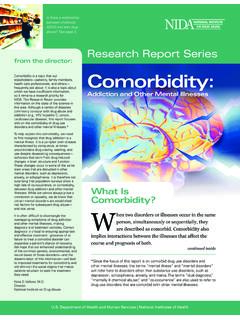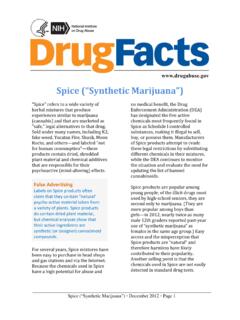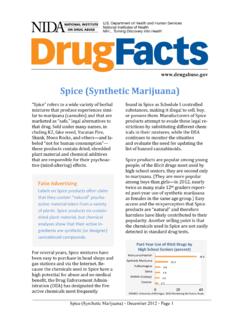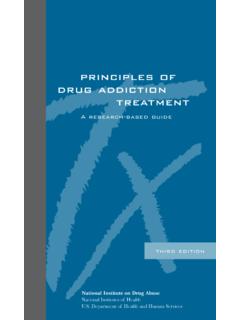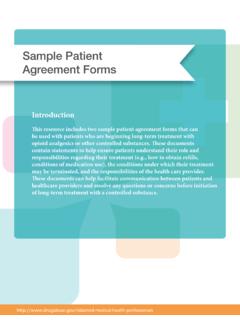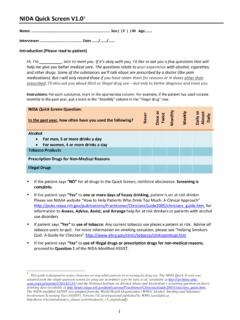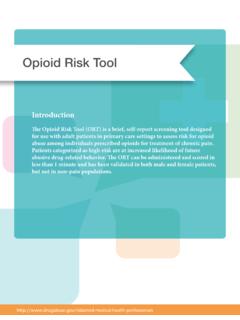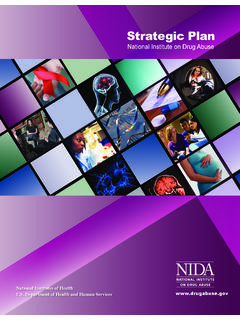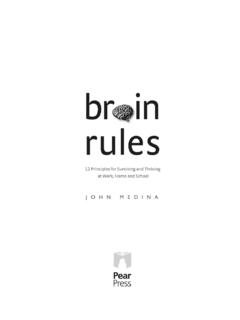Transcription of Drugs, Brains, and Behavior The Science of Addiction
1 Drugs, Brains, and BehaviorThe Science of Addiction Image: White Matter Fibers, Parietal Areas publication is in the public domain and may be used or reproduced in its entirety without permission from NIDA. Citation of the source is Pub No. 14-5605 Printed April 2007 Revised February 2008, August 2010, July Drug Abuse and Preventing Drug Abuse: The Best Drugs and the Addiction and Treatment and Advancing Addiction Science and Practical Drug Addiction is a brain disease that can be treated. Nora D. Volkow, Institute on Drug AbuseHow Science Has Revolutionized the Understanding of Drug AddictionFor much of the past century, scientists studying drug abuse labored in the shadows of powerful myths and misconceptions about thenature of Addiction . When scientists began to study addictive Behavior in the 1930s, people addicted to drugs were thought to bemorally flawed and lacking in willpower.
2 Those views shaped society s responses to drug abuse, treating it as a moral failing ratherthan a health problem, which led to an emphasis on punishment rather than prevention and treatment. Today, thanks to Science , our viewsand our responses to Addiction and other substance use disorders have changed dramatically. Groundbreaking discoveries about the brainhave revolutionized our understanding of compulsive drug use, enabling us to respond effectively to the a result of scientific research, we know that Addiction is a disease that affects both the brain and Behavior . We have identified many of thebiological and environmental factors and are beginning to search for the genetic variations that contribute to the development and progression of the disease. Scientists use this knowledge to develop effective prevention and treatment approaches that reduce the toll drug abuse takes on individuals, families, and these advances, many people today do not understand why people become addicted to drugs or how drugs change the brain to foster compulsive drug use.
3 This booklet aims to fill that knowledge gap by providing scientific information about the disease of drug Addiction , including the many harmful consequences of drug abuse and the basic approaches that have been developed to prevent and treatsubstance use disorders. At the National Institute on Drug Abuse (NIDA), we believe that increased understanding of the basics of addictionwill empower people to make informed choices in their own lives, adopt Science -based policies and programs that reduce drug abuse andaddiction in their communities, and support scientific research that improves the Nation s D. Volkow, Institute on Drug Abuse1 PREFACEThe consequences of drug abuse are vast and varied and affect people of all JUSTICEWhy study drug abuse and Addiction ?Abuse of and Addiction to alcohol, nicotine, and illicit and prescription drugs cost Americans more than $700 billion a year inincreased health care costs, crime, and lost ,2,3 Every year, illicit and prescription drugs and alcohol contribute to thedeath of more than 90,000 Americans, while tobacco is linked to an estimated 480,000 deaths per ,5(Hereafter, unless otherwise specified, drugs refers to all of these substances.)
4 People of all ages suffer the harmful consequences of drug abuse and to drugs in the womb may be born premature and underweight. This exposure can slow the child s intellectual development and affect Behavior later in abuse drugs often act out, do poorly academically, and drop out of school. They are at risk for unplanned pregnancies, violence, and infectious abuse drugs often have problems thinking clearly, remembering, and paying attention. They often develop poor socialbehaviors as a result of their drug abuse, and their work performance and personal relationships drug abuse often means chaotic, stress-filled homes, as well as child abuse and neglect. Such conditions harm the well-being and development of children in the home and may set the stage for drug abuse in the next generation.
5 How does Science provide solutions for drug abuse and Addiction ?Scientists study the effects that drugs have on the brain and on people s Behavior . They use this information to develop programs for preventing drug abuse and for helping people recover from Addiction . Further research helps transfer these ideas into practice in DRUG ABUSE AND ADDICTIONWhat is drug Addiction ? Addiction is defined as a chronic, relapsing brain disease that is characterized by compulsive drugseeking and use, despite harmful consequences. It is considered a brain disease because drugs change thebrain they change its structure and how it works. Thesebrain changes can be long-lasting, and can lead to the harmful behaviors seen in people who abuse brain METABOLISM IN PERSON WHO ABUSES DRUGSH ealthy BrainDiseased brain /Cocaine AbuserDECREASED HEART METABOLISM IN HEART DISEASE PATIENTH ealthy HeartDiseased HeartHIGHLOWA ddiction is a lot like other diseases,such as heart disease.
6 Both disrupt thenormal, healthy functioning of theunderlying organ, have serious harmfulconsequences, and are preventable andtreatable, but if left untreated, can lasta : From the laboratories of Drs. N. Volkow and H. Schelbert The term addictionas used in this booklet may be regarded as equivalent to a severe substance use disorderas defined by the Diagnostic and Statistical Manual ofMental Disorders, Fifth Edition (DSM-5, 2013).6 Why do people take drugs?In general, people begin taking drugs for a variety of reasons:zTo feel abused drugs produce intense feelings of pleasure. This initial sensation of euphoria is followed by other effects, which differwith the type of drug used. For example, with stimulants such as cocaine, the high is followed by feelings of power, self-confidence, andincreased energy.
7 In contrast, the euphoria caused by opiates such as heroin is followed by feelings of relaxation and satisfaction. zTo feel people who suffer from social anxiety, stress-related disorders, and depression begin abusing drugs in an attempt to lessen feelings of distress. Stress can play a major role in beginning drug use, continuing drug abuse, or relapse in patients recovering do people feel pressure to chemically enhance or improve their cognitive or athletic performance, which can play a role in initialexperimentation and continued abuse of drugs suchas prescription stimulants or and because others are doing it. In this respect adolescents are particularly vulnerablebecause of the strong influence of peer are more likely than adults to engage in risky ordaring behaviors to impress their friends and expresstheir independence from parental and social : Vivian Felsen7If taking drugs makes people feel good or better, what s the problem?
8 When they first use a drug, people may perceive what seem tobe positive effects; they also may believe that they can controltheir use. However, drugs can quickly take over a person s time, if drug use continues, other pleasurable activitiesbecome less pleasurable, and taking the drug becomes neces-sary for the user just to feel normal. They may then compul-sively seek and take drugs even though it causes tremendousproblems for themselves and their loved ones. Some people maystart to feel the need to take higher or more frequent doses,even in the early stages of their drug use. These are the telltalesigns of an relatively moderate drug use poses dangers. Consider howa social drinker can become intoxicated, get behind the wheelof a car, and quickly turn a pleasurable activity into a tragedythat affects many continued drug abuse a voluntary Behavior ?
9 The initial decision to take drugs is typically voluntary. However,with continued use, a person s ability to exert self-control canbecome seriously impaired; this impairment in self-control isthe hallmark of Addiction . brain imaging studies of people withaddiction show physical changes in areas of the brain that arecritical to judgment, decision making, learning and memory,and Behavior believe that these changes alterthe way the brain works and may help explain the compulsiveand destructive behaviors of do some people become addictedtodrugs, while others do not? As with any other disease, vulnerability to Addiction differs fromperson to person, and no single factor determines whether aperson will become addicted to drugs. In general, the more riskfactorsa person has, the greater the chance that taking drugsNo single factor determines whether a person will become addicted to FactorsProtective FactorsAggressive Behavior Good self-controlin childhoodLack of parental Parental monitoring supervisionand supportPoor social skillsPositive relationshipsDrug experimentationAcademic competenceAvailability of drugsSchool anti-drugat schoolpoliciesCommunity povertyNeighborhood prideRISK AND PROTECTIVE FACTORS FOR DRUG ABUSE AND ADDICTION8 Children s earliest interactions within the family are crucial to their healthy development and risk for drug lead to abuse and Addiction .
10 Protective factors, onthe other hand, reduce a person s risk of developingaddiction. Risk and protective factors may be either envi-ronmental (such as conditions at home, at school, and inthe neighborhood) or biological (for instance, a person sgenes, their stage of development, and even their genderor ethnicity). What environmental factors increase the risk of Addiction ?zHome and influence of the home envi-ronment, especially during childhood, is a very impor-tant factor. Parents or older family members who abusealcohol or drugs, or who engage in criminal Behavior ,can increase children s risks of developing their owndrug and and acquaintances can havean increasingly strong influence during peers can sway even those without risk fac-tors to try drugs for the first time.

